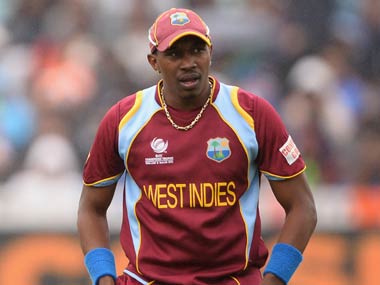To say that West Indies cricket is in dire straits would be an understatement. They have gone from bad to worse over the course of the past few years — being at the receiving end of an AB de Villiers assault more than once — and this is, in particular, evident from their performances in ODIs. When the Windies conceded 325 in the second One Day International against New Zealand at Christchurch, it was their fifth instance of giving away 300+ runs in ODIs this year. Only Sri Lanka — with eight — have worse numbers. None of their bowlers exhibited any kind of control and four of their six bowlers went at above six runs per over. This has been a trend with West Indies cricket in the preceding few years. They have been rather one-dimensional with their bowling attack, lacking ideas at the death and giving away runs at the rate of knots. [caption id=“attachment_2716326” align=“alignleft” width=“380”] Dwayne Bravo. Getty[/caption] Not on an entirely different planet — in fact, just a country away — Dwayne Bravo, an outlaw if you may call him that, completed a jaw-dropping 400 wickets in T20 cricket. That only three of them — Lasith Malinga and Sunil Narine being the others — have over 300 wickets in the shortest format of the game tells you how good Bravo is as a limited-overs bowler. Among the three with 300+ scalps, two are West Indians, another hint that their discarded players have been performing outrageously well. To put things into perspective statistically, West Indies have needed 46.6 runs/wicket on an average over the year, second only to the miserable Sri Lankans. They have also gone at an economy rate of 5.75. Interestingly, with more fielders outside the circle in recent times and better rules favouring bowlers, teams have generally been better — if only marginally — in conceding runs. Attacking captains have also meant better rate of wickets, but sadly not for West Indies.
They have been as poor as they come and the lack of variations — like the ones Bravo and Narine provide — have been a major reason for this debacle of magnanimous proportions. Another player, Samuel Badree, who has been mighty effective in T20Is for the Windies hasn’t even been given an ODI debut till date which is rather strange because the trend around the globe is to use wrist spinners to take wickets in the middle period of ODIs, where cricket admittedly gets a tad boring. But perhaps the biggest loss for the Windies has been Bravo. In October 2014, he was at the helm of Windies pulling out from an Indian tour over player-payment issues. Since then, he hasn’t figured in their scheme of things and has also been removed as Trinidad and Tobago’s skipper. Bravo’s loss coincided with Windies’ performances with the ball getting abysmal year by year. Since his last ODI in October 2014, Windies have been the worst among teams in terms of average runs per wicket and their economy rate has also been equally dismal.
The rate stands at 41.44 and economy at 5.82 in the period since Bravo’s last ODI. What makes Bravo’s absence conspicuous is that in ODIs involving the dynamic all-rounder, Windies’ runs per wicket rate drops to 31.06 and the economy to 4.99, immensely better numbers to what they have churned out without him. However, given Windies’ abominable show in recent times, a comeback for Bravo should be ideal (We are not even considering Bravo’s abilities with the bat when discussing this). But that isn’t likely to materialise with Bravo stating last week that his international career, in all likelihood, is virtually done. “I am looking at these tournaments (Big Bash) as a chance to continue playing cricket. As long as I can play cricket, I am happy. As far as internationals are concerned, I have been dropped from the West Indies team. I was dropped while I was fit. I don’t think now, at 34, it would make any sense coming back. I just need to see what is left for me, for my fans to see Dwayne Bravo playing cricket. That is my priority,” Bravo had told ESPNCricinfo. With things not looking any rosier for the Windies, they might have to relax on their policies a tad and bring back the ‘Champion, Champion’ song composer to improve their shoddy performances with the ball.


)




